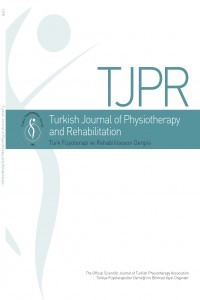SPASTİK SEREBRAL PALSİLİ ÇOCUKLARDA BİREYSEL YAPILANDIRILMIŞ GÖVDE EĞİTİMİNİN VÜCUT YAPI VE FONKSİYONU ÜZERİNE ETKİSİ: TABAKALANDIRILMIŞ RANDOMİZE KONTROLLÜ ÇALIŞMA
Serebral Palsi, Çocuk, Egzersiz, Kaslar, Rehabilitasyon
EFFECTS OF INDIVIDUALLY STRUCTURED TRUNK TRAINING ON BODY FUNCTION AND STRUCTURES IN CHILDREN WITH SPASTIC CEREBRAL PALSY: A STRATIFIED RANDOMIZED CONTROLLED TRIAL
Cerebral Palsy, Child, Exercise, Muscles, Rehabilitation,
___
- 1. Rosenbaum P, Paneth N, Leviton A, Goldstein M, Bax M, Damiano D, et al. A report: the definition and classification of cerebral palsy April 2006. Dev Med Child Neurol Suppl. 2007;109(suppl 109):8-14.
- 2. Park ES, Park CI, Lee HJ, Cho YS. The effect of electrical stimulation on the trunk control in young children with spastic diplegic cerebral palsy. Journal of Korean medical science. 2001;16(3):347-50.
- 3. Mayston MJ. People with cerebral palsy: effects of and perspectives for therapy. Neural plasticity. 2001;8(1-2):51-69.
- 4. Prosser LA, Lee SC, Barbe MF, VanSant AF, Lauer RT. Trunk and hip muscle activity in early walkers with and without cerebral palsy–A frequency analysis. Journal of Electromyography and Kinesiology. 2010;20(5):851-9.
- 5. Şimşek TT, Türkücüoğlu B, Çokal N, Üstünbaş G, Şimşek İE. The effects of Kinesio® taping on sitting posture, functional independence and gross motor function in children with cerebral palsy. Disability and rehabilitation. 2011;33(21-22):2058-63.
- 6. Footer CB. The effects of therapeutic taping on gross motor function in children with cerebral palsy. Pediatric Physical Therapy. 2006;18(4):245-52.
- 7. Tseng S-H, Chen H-C, Tam K-W. Systematic review and meta-analysis of the effect of equine assisted activities and therapies on gross motor outcome in children with cerebral palsy. Disability and rehabilitation. 2013;35(2):89-99.
- 8. Gonca A, GÜNEL MK. Serebral palsili çocuklarda nörogelişimsel tedaviye dayalı gövde eğitiminin gövde kontrolüne etkisi. Journal of Exercise Therapy and Rehabilitation. 2015;2(3):79-85.
- 9. Arı G, Günel MK. A Randomised Controlled Study to Investigate Effects of Bobath Based Trunk Control Training on Motor Function of Children with Spastic Bilateral Cerebral Palsy. International Journal of Clinical Medicine. 2017;8(04):205.
- 10. [Available from: http://www.seniam.org/.
- 11. Kasman GS, Wolf SL. Surface EMG made easy: a beginner's guide for rehabilitation clinicians: Noraxon USA; 2002.
- 12. Hermens HJ, Freriks B, Disselhorst-Klug C, Rau G. Development of recommendations for SEMG sensors and sensor placement procedures. Journal of electromyography and Kinesiology. 2000;10(5):361-74.
- 13. Beith I, Synnott R, Newman S. Abdominal muscle activity during the abdominal hollowing manoeuvre in the four point kneeling and prone positions. Manual therapy. 2001;6(2):82-7.
- 14. Chanthapetch P, Kanlayanaphotporn R, Gaogasigam C, Chiradejnant A. Abdominal muscle activity during abdominal hollowing in four starting positions. Manual therapy. 2009;14(6):642-6.
- 15. Haugh A, Pandyan A, Johnson G. A systematic review of the Tardieu Scale for the measurement of spasticity. Disability and rehabilitation. 2006;28(15):899-907.
- 16. Numanoglu A, Gunel MK. Intraobserver reliability of modified Ashworth scale and modified Tardieu scale in the assessment of spasticity in children with cerebral palsy. Acta orthopaedica et traumatologica turcica. 2012;46(3):196-200.
- 17. Boyd RN, Graham HK. Objective measurement of clinical findings in the use of botulinum toxin type A for the management of children with cerebral palsy. European Journal of Neurology. 1999;6(S4):s23-s35.
- 18. Damiano DL, Dodd K, Taylor NF. Should we be testing and training muscle strength in cerebral palsy? Developmental Medicine & Child Neurology. 2002;44(01):68-72.
- 19. Ayalon M, Ben‐Sira D, Hutzler Y, Gilad T. Reliability of isokinetic strength measurements of the knee in children with cerebral palsy. Developmental Medicine & Child Neurology. 2000;42(6):398-402.
- 20. Berry ET, Giuliani CA, Damiano DL. Intrasession and intersession reliability of handheld dynamometry in children with cerebral palsy. Pediatric Physical Therapy. 2004;16(4):191-8.
- 21. dos Santos CG, Pagnussat AS, Simon A, Py R, do Pinho AS, Wagner MB. Humeral external rotation handling by using the Bobath concept approach affects trunk extensor muscles electromyography in children with cerebral palsy. Research in developmental disabilities. 2015;36:134-41.
- 22. Heyrman L, Desloovere K, Molenaers G, Verheyden G, Klingels K, Monbaliu E, et al. Clinical characteristics of impaired trunk control in children with spastic cerebral palsy. Research in developmental disabilities. 2013;34(1):327-34.
- 23. Fowler EG, Ho TW, Nwigwe AI, Dorey FJ. The effect of quadriceps femoris muscle strengthening exercises on spasticity in children with cerebral palsy. Physical Therapy. 2001;81(6):1215-23.
- 24. Lee Y-s, Kim W-b, Park J-w. The Effect of Exercise Using a Sliding Rehabilitation Machine on the Gait Function of Children with Cerebral Palsy. Journal of physical therapy science. 2014;26(11):1667.
- ISSN: 2651-4451
- Başlangıç: 1974
- Yayıncı: Türkiye Fizyoterapistler Derneği
SAĞLIK PROFESYONELLERİNDE SİGARA İÇİCİLİĞİ İLE FİZİKSEL AKTİVİTE ARASINDAKİ İLİŞKİNİN İNCELENMESİ
İlknur NAZ GÜRŞAN, Hülya ŞAHİN, Nimet AKSEL
Güler DURU AŞİRET, Gülcan BAĞCIVAN, Cemile KÜTMEÇ YILMAZ
Ayşe NUMANOĞLU AKBAŞ, Mintaze KEREM GÜNEL
Sümeyye TUNÇ, Esra ATILGAN, Candan ALGUN
LUMBOPELVİK MOTOR KONTROL, POSTÜRAL DENGE VE FİZİKSEL PERFORMANS ARASINDAKİ İLİŞKİ
Caner KARARTI, Sevil BİLGİN, Öznur BÜYÜKTURAN, Buket BÜYÜKTURAN, Yeliz DADALI, Nilgün BEK
